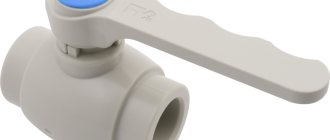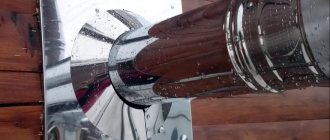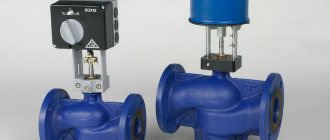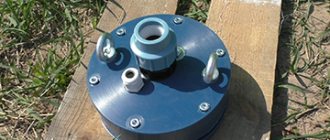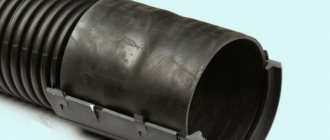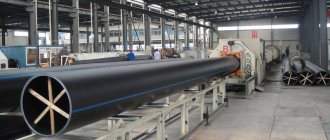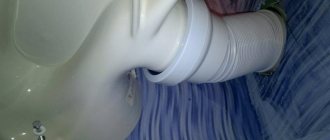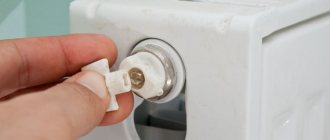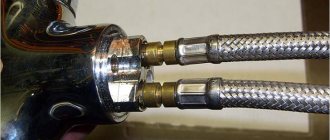Hello again!
The modern concept of water supply is based on the principle of maximum efficiency. Therefore, the water supply system is equipped with a variety of fittings, mixers, and valves. This equipment allows you to regulate the flow of media in the pipeline, block its individual sections for replacing pipes, expanding and rebuilding the pipeline.
We dedicate today's material to water taps. You will learn what role they play in the water supply system, what they are like and how they are installed.
Purpose and scope
When drawing water from a tap, we don’t even think about the fact that this is not its only function. Depending on the design, the pipeline valve can:
- mix flows of cold and hot water, adjusting the desired temperature;
- heat water when serving;
- regulate the pressure;
- direct the flow in a given direction;
- completely or partially block the flow of water in a certain section of the pipeline;
When it comes to a water tap, it naturally means its use for working with the aquatic environment in the municipal, domestic and industrial spheres:
- directly at water intake points;
- at the introduction of pipes into the system;
- in places where the pipeline is laid out;
- in places where metering devices, pumping equipment, etc. are installed.
However, crane mechanisms are also actively used in pressure sewers, main oil and gas pipelines and other areas related to the transportation of all kinds of gaseous and liquid carriers.
Ball valves
All types of ball valves represent an in-depth study of errors in the design of plug valves.
The plug in them is a ball with a through channel equal to the diameter of the connected pipeline. It is sealed with two ring seats made of low friction polymer. As a rule, the rod is sealed with it.
Materials – brass and (less commonly) stainless steel; Teflon or fluoroplastic act as a sealant. Dimensions – from DN50 to DN500.
Execution
Different types of ball valves used in in-house utility networks differ from each other primarily in the design and shape of the body.
- The pipeline can be connected by threads, flanges or welding.
- The body can be dismountable (with threads or studs) or all-welded.
- The handle can be stationary or removable, in the shape of a lever or a “butterfly”.
- The valve can be combined with an arbitrary fitting or a coarse filter.
Characteristic
Let's be concise: ball valves do not have any of the disadvantages listed above. Malfunctions are extremely rare and mainly boil down to the need to tighten the worn-out seal around the rod after several hundred opening-closing cycles.
Sectional view of a ball valve.
Characteristics
GOSTs 19681-94 and 25809-96 standardize the classification of water fittings in accordance with the technical characteristics of the products:
- in terms of throughput: Standard, passing 70-80% of the media;
- Full bore, allowing 90-100% of the media to pass through;
- Partial bore, allowing 40-50% of the media to pass through.
- 1 class – up to 1 MPa;
- by noise level: group 1 – 20 decibels or less;
- Group 2 – 30-20 decibels;
- Group 3 – more than 30 decibels.
Product characteristics are applied to the packaging in the form of markings and are indicated in the accompanying technical documentation.
Worm
In such a mixer, a worm gear moves a rod with a cuff, which blocks the passage for water.
The main advantages of this type are: reliability and cheap production. In addition, repairing such a mixer is quite easy, you just need to change the cuff
The disadvantages include the long rotation of the valve, several turns, to fully open the stem.
Crane device
The basic design of a pipeline valve includes:
- frame;
- Control block;
- bolt mechanism;
- technical opening for passage of aqueous medium;
- sealing gaskets.
However, this scheme is extremely generalized, because Each type of crane has its own structural features.
The photo below shows the structure of a regular household faucet:
You can see what the technical valve valve used to regulate the flow consists of in the following diagram:
Which spouts to choose
Faucets with long spouts are now in demand on the market. They can be secured between the bathtub and sink for more convenient use, but constant turning of such a spout weakens the connections.
When buying bathroom faucets with a long tap, you need to choose models with a length of 30 cm or more, with a large turning radius.
Short spouts have been on sale for a short time and are already in demand among buyers. The advantages of such spouts: the ability to install directly next to the bathtub, as well as their small dimensions.
Photos of the bathroom mixer tap are presented below.
Differences between a faucet and a valve
The main difference between a tap and a valve is based on the fundamental difference in the operation of the valve mechanism.
The shutter element of the taps rotates around its axis. Moreover, its location relative to the flow of the working environment can be arbitrary.
In gate valves, the gate moves translationally (up and down) and perpendicular to the transported medium. Such a device is more susceptible to wear, which is why valves are used exclusively as a shutter mechanism.
Spout nozzle
According to their structure, nozzles are divided into 2 types: aerator and shower - watering can.
In the aerator, the process of mixing water with air takes place and therefore, when the tap is not fully opened, a strong water pressure is obtained, which saves water.
The shower head is a classic type that operates in two modes: jet and shower. This nozzle is more convenient to use than an aerator.
Types and designs
First of all, water taps are classified according to their purpose:
- For domestic needs - mixing and valve type taps.
- For household and municipal needs - water intake, irrigation, etc.
- To adjust the water supply - technical (coupling).
Based on the direction of flow, tap devices are divided into:
- pass-through (standard), which does not change the movement of the carrier;
- angular (rotary);
- three-way (mixers, tees).
According to the shutter configuration there are:
- Ball (cartridge).
The valve is a ball with a round through hole through which water is supplied when the ball is turned 90⁰, the reverse movement blocks the flow. Depending on the diameter of the bore, the ball valve can be floating (for small diameters) or supporting.
They are characterized by low hydraulic losses, reliable tightness and easy control.
- Conical (cork).
The locking element is made in the shape of a cone (plug), sometimes with a trapezoidal passage hole. Depending on the device, the plugs open and close either by raising/lowering the shutter, or by rotating it around its axis. Depending on the method of sealing, there are gland seals and tension seals.
The disadvantage of the design is the need for regular lubrication of the bolt mechanism, because over time, it sticks to the body, which complicates the operation of the faucet and leads to loss of tightness and rapid wear.
- Cylindrical.
The valve is made in the form of a cylinder, the movement of which opens or closes the tap.
The drawback is the lack of complete tightness, which is why taps of this type are used primarily to regulate the intensity of flow.
Based on the type of design solution, mixers are divided into:
- Single valve.
The simplest and, today, outdated design. They are not intended for mixing water flows supplied from different pipes, because... installed on the principle of one faucet - one pipe. The reciprocating movement of the valve activates the axle box built into the housing, opening and closing the device.
Crane mechanisms of this type are now found, perhaps, only in dachas, in old apartments, in irrigation or heating systems, when a faucet is installed on the radiator to drain the coolant.
- Two-valve.
A modern solution that simultaneously supplies water and mixes flows supplied from two different pipes, and regulates the pressure and temperature of the medium by simultaneously opening one or two valves.
- Single lever.
Raising the lever activates the locking and adjustment mechanism, the role of which is performed by a three-way ball valve. It mixes cold and hot water flows and gives the consumer the desired temperature.
By type of control of the crane mechanism:
- manual (valve and lever);
- electrical;
- pneumatic;
- hydraulic.
A separate group includes models with a thermostat and touch sensors:
- With built-in thermostat.
Innovation in the world of plumbing. Built-in software and thermostat regulate both temperature and water flow. The control panel can be mechanical or electronic. The power supply can be powered by batteries or a rechargeable battery.
Plus - economical water consumption. The downside is the high cost of both the crane itself and its repair in the event of a breakdown.
- Touch (non-contact).
The tap is pre-programmed to dispense water at a certain pressure and temperature. Control is carried out automatically by means of an opening or closing command coming from the built-in infrared touch sensor.
Due to the complexity of constant adjustment, sensor faucets are practically not used at home. The advantage is a high degree of hygiene due to the lack of direct contact with the tap and savings in water consumption.
Plug valves
The water is blocked by turning the plug ground into the body. Tightness is ensured by the almost complete absence of a gap between the plug and the body. Materials are metals with a relatively low coefficient of friction, not prone to corrosion and sticking of adjacent surfaces to each other: cast iron and brass.
In apartment buildings, valves measuring 15–40 mm are widely used.
Execution
In this case, classification of cranes by type is also possible according to several criteria.
- The body can be prefabricated or monolithic.
- The tightness of the plug rod can be ensured by a stuffing box with pressure from the gland or by the force of pressing the plug to the body. In the latter case, it is attracted by a nut on a shank passing through the body.
This design is called a tension crane.
- The valve can be equipped with a handle or closed with a key.
Characteristic
Advantages:
- Low price due to the simplicity of the crane design.
- A fairly wide through channel in the plug, allowing the valve not to become clogged with debris.
Flaws:
- With stuffing box valves there is constant leakage of the stuffing box when closing and opening, with tension valves there is a risk of the shank coming off.
Note: to pack the plug valve seal with your own hands, you will have to drain the pipeline on both sides of it. Otherwise, the disturbed plug may fly out of the housing at the front of the water flow.
- Large force required to change the position of the tap.
- High hydraulic resistance.
Tips for choosing
When choosing a water tap, you should follow the conditions in which you plan to operate the device and the requirements for functionality:
- If you plan to regulate the media flow, then ball mechanisms are not the most suitable solution; in the half-closed position they quickly wear out.
- Plastic (polyethylene or polypropylene) models are cheaper, but are inferior in strength and service life to their steel counterparts.
- Pay attention to the weight of the device. The heavier, the more internal parts are made of steel, which means the better the quality.
- The sizes of pipes and inlet pipes of the faucet must match.
When purchasing, the type of installation is also taken into account.
External
Advantages: ease of installation and replacement, ease of maintenance.
Disadvantages: inconvenient to use, plus, if the faucet mixer for the bathroom and washbasin is located between them, then when the spout is moved frequently, the connections begin to leak.
Installation and operation rules
There are 3 installation methods:
- built-in, when the internal parts of the mixer and the pipeline itself are built into the walls, floor or plumbing duct;
- typesetting, in which the mixer is installed directly on the sink or bathtub, and the wiring is routed under the plumbing;
- wall-mounted, when water pipes pass directly along the wall and a mixer is connected to them.
Required tools and materials
- Threading machine.
- Soldering iron for plastic pipes.
- Adjustable (Swedish) wrench.
- Pipe (gas) wrench.
- Pliers.
- Fum tape.
- Rags.
Work progress
- The water flow is blocked on the working section of the pipe.
- Threads are cut into the inside of metal pipes. An adapter is soldered to the plastic pipes.
- The eccentrics/adapters are screwed in, and the connection is sealed with fum tape.
- If necessary, the mixer body is assembled.
- The mixer pipes are connected to eccentrics, sealed with fum tape and secured with union nuts.
- Finally, the water is turned on and the operation of the circuit is checked.
How to remove the old one
Before starting work, turn off the water supply to the tap and drain the remaining residues that are in the pipes. Now you can start replacing your kitchen faucet. To remove the old faucet from the sink, you need to unscrew the nut that is screwed onto its body from the bottom of the sink. If the sink is installed in a kitchen cabinet, it is very inconvenient to work. It's better to remove the sink. To do this you will have to:
Unscrew the siphon. There are many siphon designs, but each has a nut that needs to be unscrewed. It is difficult to confuse - it has protrusions for better grip. Unscrew the nut and remove the lower part of the siphon. Unscrew the hot and cold water hoses that go to the mixer. The union nuts are usually removed. To do this, you will need a 22 or 24 wrench. Trim the sealant around the perimeter of the sink, if any. Unscrew the bolts securing the sink to the countertop. You will see the bolts if you “dive” into the table. One of the siphon options and a nut that needs to be twisted
Now you can lift the sink and turn it over. Here you will see a nut that needs to be unscrewed. For this job you will need two adjustable wrenches. One holds the body on the “front” side of the sink, the other unscrews the nut.
Sometimes it is very difficult to remove an old faucet in the kitchen: it gets stuck. For this case, kerosene or universal lubricant in WD-40 cans is suitable. Both substances have low density and are able to seep into microscopic cracks. The compound or kerosene is applied to the connection that needs to be disassembled, wait 10-15 minutes, and try to unscrew it.
If all the tricks do not help, there is a simple method that is suitable if you are not going to use the old mixer anywhere else: you can use a grinder to cut the body together with the nut. The method is tough, but after suffering for an hour trying to remove the nut, they resort to it.
If the faucet is installed on a countertop, you will have to work “from the inside” - crawl into the cabinet with a flashlight and unscrew the nut.
Kitchen renovation 9 sq. m. with photos, see here.
A few words in conclusion
A mixer is an important element of kitchen equipment, but the large assortment of models presented on the Russian market can make it difficult to purchase a suitable product. However, if you decide in advance on the structures, functionality, design, installation location and manufacturer, then the choice will not become a particular problem.
Sources:
- https://moysantehnik.ru/vidy-smesiteli/
- https://irkutsk.tbmmarket.ru/help/useful-articles/item/4767/kak-vybrat-smesitel/
- https://penaty.net/stati/sovremennye-vidy-smesitelej-i-ih-otlichitelnye-osobennosti/
- https://9999812.ru/poleznoe/kakie_smesiteli_byvayut/
- https://srbu.ru/santekhnika-i-vodosnabzhenie/234-vidy-smesitelej.html
- https://polimer-vrn.ru/articles/kak-vybrat-kukhonnyy-smesitel/
Single lever bath and shower mixers
Structurally, single-lever faucets with shower do not differ from similar models installed on sinks. The only difference between the products is that the first ones are made with a cast body. Single-lever faucets with showers differ in the mechanism for switching the water supply.
Products are of the following types:
- faucets with a removable switching mechanism;
- faucets with built-in cork switching mechanism;
- faucets with built-in cartridge switching mechanism.
The first type of mixers is available with a cork or rotary switching mechanism. The last option is easy to use. If the rotary mechanism breaks down, the elements responsible for switching are removed and replaced with new ones.
Such single-lever faucets with showers are convenient because consumables are easy to find. Therefore, repairing failed parts is quite simple. Among the disadvantages of single-lever faucets with a rotary mechanism, it is worth highlighting their large dimensions. Due to the fact that the shower hose is located at the bottom, the products should be installed at some distance from the bathroom.
Faucets with a plug mechanism include a stem with rubber gaskets (plugs). To switch the water flow, you need to pull or press this element.
Faucets with a cork mechanism are distinguished by their attractive appearance and relatively small dimensions. Repairing such models is complex, and finding the necessary parts can be difficult.
Faucets with a cartridge mechanism are considered the most reliable. They are easy to install. But if the cartridge breaks, you have to replace it with a new one.
Which shower head to choose
There is a huge range of products on the market, differing in form, functionality, raw materials for production.
The main materials for production are metal and plastic.
Watering cans made of metal have advantages over plastic: they are durable, strong, but plastic models are cheaper than metal ones.
DESIGN
Currently, end consumers place demands on faucets not only as a sanitary product with practical and functional properties, but also as an integral design element. Therefore, faucets for bathtub, kitchen, washbasin, bidet and shower are made in series so that the consumer can maintain a single style when carrying out renovation work. The specialists responsible for developing the design of faucets are not inferior in dynamics to designers designing the renovation of an apartment or house.
